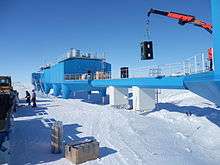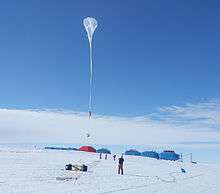BARREL


Balloon Array for RBSP Relativistic Electron Losses (BARREL) is a NASA mission operated out of Dartmouth College that works with the Van Allen Probes mission (formerly known as the Radiation Belt Storm Probes mission).[1] The BARREL project has launched 20 balloons from Antarctica during each of two balloon campaigns in January 2013 and January 2014. Unlike the football-field-sized balloons typically launched at the Poles, these are each just 90 feet in diameter.[2]
Scientific Objectives
BARREL will help study the Van Allen Radiation Belts and why they wax and wane over time. Each BARREL balloon carries instruments to measure particles ejected from the Belts which make it all the way to Earth's atmosphere.[2] By comparing such data to that of RBSP—which is up beyond the atmosphere observing the Belts from a closer viewpoint—the two experiments can try to correlate observations in the Radiation Belts with the number of particles ejected.[3] This will help distinguish between various theories of what causes electron loss in the Belts.[4]
Organization
The Principal Investigator is Robyn Millan at Dartmouth College. Co-Investigator institutions are University of Washington, U. C. Berkeley, and U. C. Santa Cruz. BARREL is part of NASA's Living With a Star program.[3] Support for the Antarctica balloon campaigns is provided by the National Science Foundation, British Antarctic Survey, and South African National Antarctic Program.
References
- ↑ "Van Allen Probes: NASA Renames Radiation Belt Mission to Honor Pioneering Scientist". Reuters. Science Daily. 11 November 2012. Retrieved 2012-11-12.
- 1 2 Karen C. Fox. "Launching Balloons in Antarctica". NASA.
- 1 2 "Living With A Star Program: Missions". NASA.
- ↑ "Balloon Array for RBSP Relativistic Electron Losses". Dartmouth Balloon Program.
